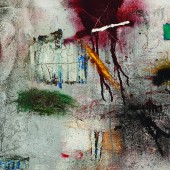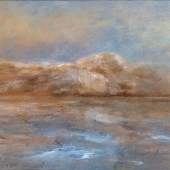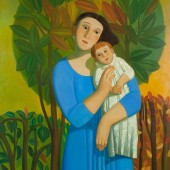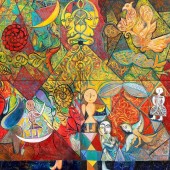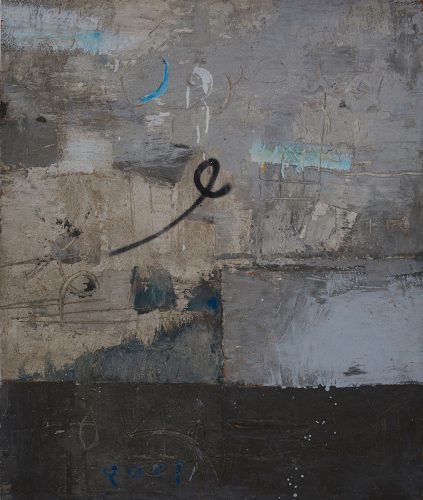
This work by celebrated Iraqi artist Shakir Hassan Al Said belongs to a series of mixed media, tactile works in which he suspends isolated Arabic letters (here, the waw) against abstracted compositions, suggestive of graffiti written on a concrete wall. In the mid-20th Century, a number of artists in the Arab region began exploring the Arabic letter as a source of inspiration and Al Said was chief among them. This painting, from a later period, represents the artist’s aesthetic theory, the One Dimension (founded in 1971) which explores the spiritual, dimensions of calligraphic representation and contemplates the dimensions of the pictorial surface. Incorporating philosophical sources such as Sufi thought and Deconstruction, Al Said’s approach to art making experimented with repetitive gestures and lacerations of pictorial surfaces as a way to transcend into the realm of the divine, considered the One Dimension.
Al Said was a prolific painter, sculptor, and writer whose work incorporates a range of influences, from international modernism to Arab-Islamic popular culture and Sufism. Al Said pursued painting at Baghdad’s Institute of Fine Art where he studied under Jewad Selim. In 1951, Al Said co-founded, with Selim, the Baghdad Group for Modern Art. In 1955, Al Said continued his studies in Paris, returning to Baghdad in 1959 to teach at the Institute of Fine Arts. His work is held in private collections and museums worldwide. Al Said died in Baghdad, in 2004.
ينتمي هذا العمل للفنان العراقي الشهير شاكر حسن آل سعيد إلى سلسلة من الوسائط الفنية المتعددة والأعمال المجسمة التي يعلّق فيها الفنان حروفاً عربية على نحو منعزل (في هذه اللوحة يعلّق حرف الواو) على تراكيب تجريدية لتبدو كأنها رسومات جرافيتي على جدار إسمنتي. وفي منتصف القرن الماضي بدأ عدد من الفنانين في المنطقة العربية، وعلى رأسهم آل سعيد، باستكشاف الحرف العربي كمصدر للإلهام. وتمثّل هذه اللوحة، التي تعود إلى حقبة تالية، النظرية الجمالية للفنان آل سعيد وجماعة “البُعد الواحد” الفنية التي تأسست عام 1971. حيث تستكشف هذه النظرية الأبعاد الروحية للحروف العربية وتتأمل أبعاد السطح التصويري. ومن خلال دمج المصادر الفلسفية مثل الفكر الصوفي والنظرية التفكيكية، جرّب آل سعيد أسلوبه في صنع الفن عبر استخدام إيماءات متكررة وتمزقات في الأسطح التصويرية كطريقة للانتقال إلى العالم الإلهي مجسداً بذلك نظرية “البعد الواحد”.
كان آل سعيد رساماً ونحاتاً وكاتباً غزير الإنتاج، وتضمنت أعماله العديد من التأثيرات بدءاً من الحداثة العالمية إلى الثقافة العربية الإسلامية وصولاً إلى الصوفية. بدأ آل سعيد دراسة الرسم في معهد الفنون الجميلة ببغداد، وتتلمذ هناك على يد جواد سليم الذي ساهم معه بتأسيس “جماعة بغداد للفن الحديث” عام 1951. وفي عام 1955، تابع آل سعيد دراساته في باريس ثم عاد إلى بغداد عام 1959 ليدرّس في معهد الفنون الجميلة. ويتم عرض أعماله اليوم في العديد من المجموعات الخاصة والمتاحف حول العالم. توفي آل سعيد في بغداد، عام 2004.




